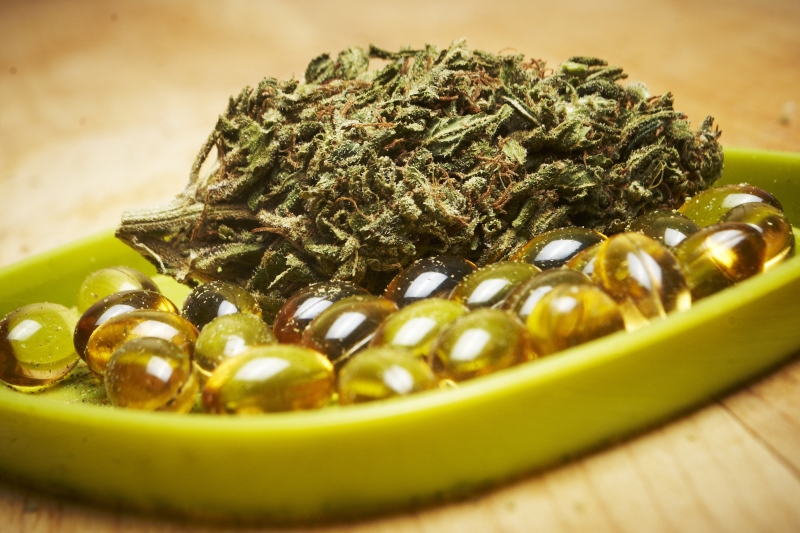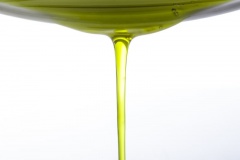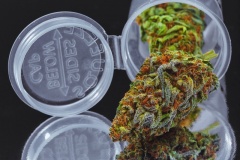Cannabis Antibiotics to Fight MRSA
Some bacteria nowadays are evolving so fast that scientists cannot catch up with them. Already, some illnesses that have been successfully treated before cannot be dealt with today. To eliminate the risk of dying from once treatable diseases, we resort to alternative remedies.

One of the reasons for the lack of development in medicine is the fact that during the last few decades, no new classes of antibiotics have been found. However, the current fascination of the world with cannabis leads to new research. In the depths of marijuana studies, scientists hope to find novel antibiotics of the natural world.
Thus far, the plant has successfully proved its benefits in treating various ailments. Its phytochemicals help patients deal with the consequences of chemotherapy, reduce epileptic seizures, and provide pain relief. Moreover, it is one of those rare remedies that can be used by children.

CBD Oil Use in Pediatrics
Though today we all have heard about the health benefits of CBD and the component's potential in pediatrics. However, it was not always this way. When did we start studying this component of cannabis and its use in medicine?
Continue reading
One of the most recent findings states that the resin that coats marijuana buds contains potent antibiotics. The plant's antibacterial properties have already been studied and claimed to be effective. In addition, scientists have shown the world that cannabinoids can beat Staphylococcus aureus resistant to meticillin—a narrow-spectrum antibiotic of the penicillin class.
Scientists knew about the antibacterial properties of the plant long ago. At first, cannabis was used as an antiseptic for mouth and skin. In addition, it is believed that this plant developed cannabinoids to have them serve as an external immune system that would protect it from environmental dangers.

California Researchers Warn Marijuana Patients Against Mold and Bacteria
California scientists have tested marijuana samples from 20 dispensaries across the state. Some samples were contaminated with potentially lethal mold and bacteria. Researchers recommend marijuana patients to restrain from smoking and vaping dangerous weed flowers.
Continue reading
Weed has proved to be effective as an antibiotic. However, scientists still do not know how exactly its compounds work. They assumed that cannabinoids had the same targets as common antibiotics, but studies have revealed that they do not.
All in all, the plant produces more than a hundred different cannabinoids with antibacterial properties. However, there are five compounds that have the most potential.
The constant medical focus is on cannabidiol (CBD). This non-psychoactive cannabinoid has been studied a lot lately due to its effectiveness against seizures. Its rich list of useful properties also contains the ability to fight infection. According to the studies, cannabinoids are unaffected by the mechanism that superbugs use to evade antibiotics. In addition, scientists believe that, in the future, we will not have to use the psychoactive THC to treat infections. CBD can be extracted from hemp plants to create cheap antibiotics.
Though THC is less popular than CBD in the medical community, it has strong antibacterial properties as well. Researchers find that almost immediately after this cannabinoid is isolated, it can kill streptococci and staphylococci, which cause a wide variety of diseases.
Cannabinol (CBN) is a breakdown product of THC. Alongside the two previous compounds, this cannabinoid is one of the few chemicals that can treat methicillin-resistant Staphylococcus aureus (MRSA).
The next compound is less discussed than its “siblings” but is present in some strains in equal ratios to CBD. Cannabichromene, CBC, was studied back in 1981. The researchers found that it not only had antibacterial properties but was also effective against such common bugs as E. coli and Candida albicans.
The last compound that can be used as an antibiotic is cannabigerol (CBG). It is like a stem cell or a template that fosters all other cannabinoids. It is abundant in young plants and differentiates into various cannabinoids as the plant matures. Previously, CBG showed modest antibacterial properties. Lately, it has been considered effective against MRSA as well.
Again I say, wow..... is there anything that Cannabis can't be effective for?
Some bacteria nowadays are evolving so fast that scientists cannot catch up with them. Already, some illnesses that have been successfully treated before cannot be dealt with today. To eliminate the risk of dying from once treatable diseases, we resort to alternative remedies.

One of the reasons for the lack of development in medicine is the fact that during the last few decades, no new classes of antibiotics have been found. However, the current fascination of the world with cannabis leads to new research. In the depths of marijuana studies, scientists hope to find novel antibiotics of the natural world.
Thus far, the plant has successfully proved its benefits in treating various ailments. Its phytochemicals help patients deal with the consequences of chemotherapy, reduce epileptic seizures, and provide pain relief. Moreover, it is one of those rare remedies that can be used by children.

CBD Oil Use in Pediatrics
Though today we all have heard about the health benefits of CBD and the component's potential in pediatrics. However, it was not always this way. When did we start studying this component of cannabis and its use in medicine?
Continue reading
One of the most recent findings states that the resin that coats marijuana buds contains potent antibiotics. The plant's antibacterial properties have already been studied and claimed to be effective. In addition, scientists have shown the world that cannabinoids can beat Staphylococcus aureus resistant to meticillin—a narrow-spectrum antibiotic of the penicillin class.
Scientists knew about the antibacterial properties of the plant long ago. At first, cannabis was used as an antiseptic for mouth and skin. In addition, it is believed that this plant developed cannabinoids to have them serve as an external immune system that would protect it from environmental dangers.

California Researchers Warn Marijuana Patients Against Mold and Bacteria
California scientists have tested marijuana samples from 20 dispensaries across the state. Some samples were contaminated with potentially lethal mold and bacteria. Researchers recommend marijuana patients to restrain from smoking and vaping dangerous weed flowers.
Continue reading
Weed has proved to be effective as an antibiotic. However, scientists still do not know how exactly its compounds work. They assumed that cannabinoids had the same targets as common antibiotics, but studies have revealed that they do not.
All in all, the plant produces more than a hundred different cannabinoids with antibacterial properties. However, there are five compounds that have the most potential.
The constant medical focus is on cannabidiol (CBD). This non-psychoactive cannabinoid has been studied a lot lately due to its effectiveness against seizures. Its rich list of useful properties also contains the ability to fight infection. According to the studies, cannabinoids are unaffected by the mechanism that superbugs use to evade antibiotics. In addition, scientists believe that, in the future, we will not have to use the psychoactive THC to treat infections. CBD can be extracted from hemp plants to create cheap antibiotics.
Though THC is less popular than CBD in the medical community, it has strong antibacterial properties as well. Researchers find that almost immediately after this cannabinoid is isolated, it can kill streptococci and staphylococci, which cause a wide variety of diseases.
Cannabinol (CBN) is a breakdown product of THC. Alongside the two previous compounds, this cannabinoid is one of the few chemicals that can treat methicillin-resistant Staphylococcus aureus (MRSA).
The next compound is less discussed than its “siblings” but is present in some strains in equal ratios to CBD. Cannabichromene, CBC, was studied back in 1981. The researchers found that it not only had antibacterial properties but was also effective against such common bugs as E. coli and Candida albicans.
The last compound that can be used as an antibiotic is cannabigerol (CBG). It is like a stem cell or a template that fosters all other cannabinoids. It is abundant in young plants and differentiates into various cannabinoids as the plant matures. Previously, CBG showed modest antibacterial properties. Lately, it has been considered effective against MRSA as well.
Again I say, wow..... is there anything that Cannabis can't be effective for?


